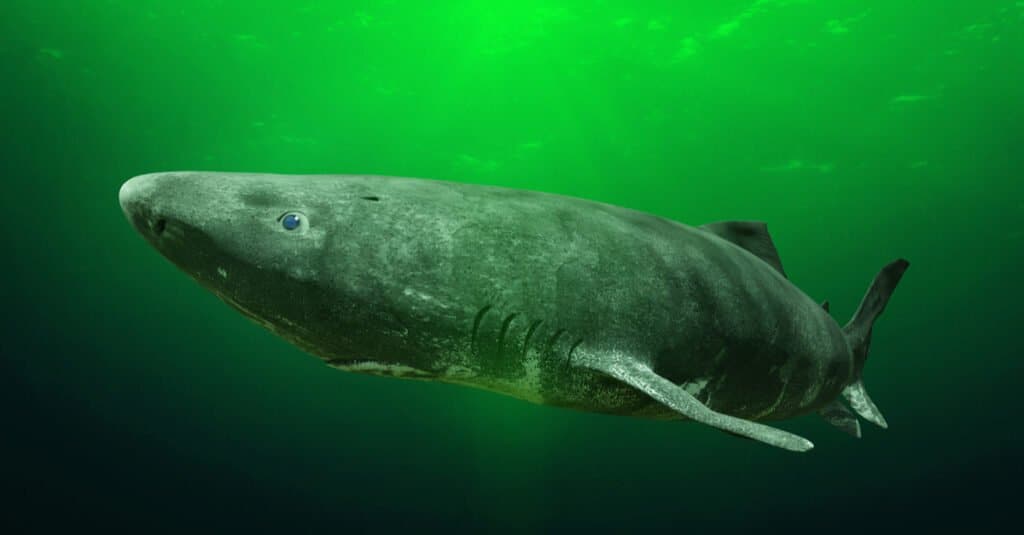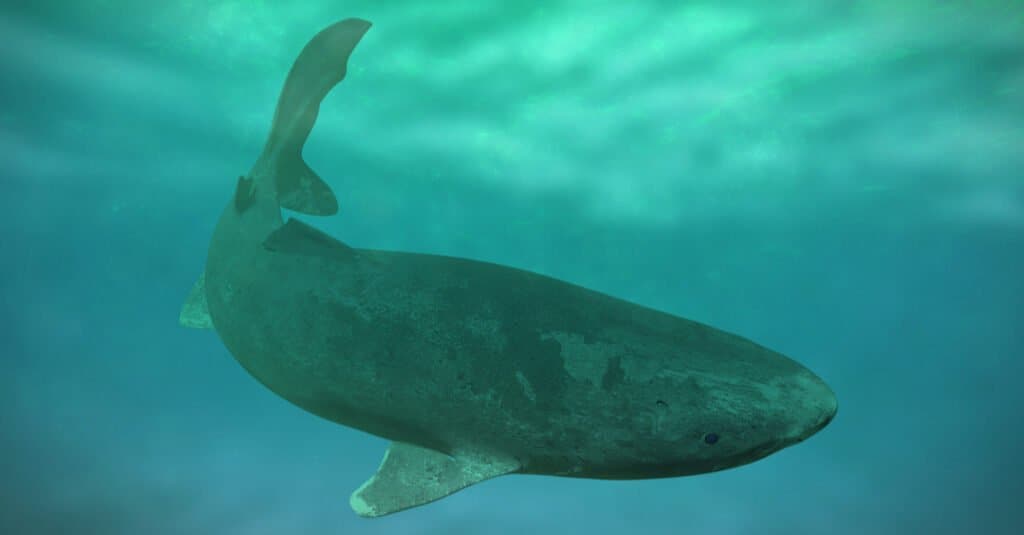Key Points:
- The Greenland shark, which can reach 23 feet long and weigh up to a whopping 2,200 pounds, is remarkably slow to mature, with a gestation period of eight to 18 years. Then, as it grows less than an inch per year, it can take 150 years to reach full maturity.
- Through radiocarbon dating tests on eye tissue samples from 28 Greenland sharks, scientists found the oldest shark in the sample was likely aged between 272 and 512 years, which would mean it was born between 1501 and 1744.
- One reason these sharks could live so long is that they have a very low resting metabolism due to how slow they swim: slower than one mile per hour.
The Greenland shark, also known as the gurry shark or the gray shark, may not inspire the same mixture of terror and awe in people as the great white shark, but this huge carnivorous fish is perhaps every bit as fascinating. This species is an official member of the sleeper shark family, sharing a close relationship with the Pacific sleeper shark and longnose sleeper shark. The family has earned this name because of their slow swimming speeds and non-aggressive behavior.
Native to the North Atlantic and Arctic Oceans, the Greenland shark moves leisurely through the water while hunting for squid, flounder, wolffish, seals, and even smaller sharks. During the summer, the shark lurks at depths of more than 7,000 feet along the continental shelf, where the water nearly drops down to freezing temperatures. In the winter, it migrates to shallow waters near the shore and congregates together with other members of the species. Certain molecules coursing through the body help them survive in high-pressure environments (though if ingested by humans, this molecule can be very dangerous and perhaps life-threatening).
What Does the Greenland Shark Look Like?

The Greenland shark can reach a maximum weight of more than 2,000 pounds.
©Dotted Yeti/Shutterstock.com
While many people may not have heard of this species, it is just as large, and sometimes even larger, as the great white. Characterized by a rounded snout, small eyes, and comparatively short fins, the Greenland shark can grow up to 23 feet long and weigh a maximum of 2,200 pounds, although the average is somewhere between 6.5 and 13 feet. Females are generally larger than males, probably due to the need of carrying so many young at once.
Perhaps the most remarkable fact about the Greenland shark is that they are remarkably slow to mature, from the moment of conception until adulthood. They remain in the mother’s womb for a gestation period of eight to 18 years and then after birth only measure about 15 to 17 inches in length. Since they grow less than an inch per year, it can take about 150 years to reach full maturity. This means multiple generations of people will have been born and died by the time this shark can even start to reproduce.
What Is the Greenland Shark’s Lifespan?
Their slow maturation process suggests they have a very long lifespan, perhaps eclipsing any other vertebrate species. Without any hard data, however, no one could know for sure exactly what was the world’s oldest Greenland shark. It has proven to be surprisingly difficult to estimate their age based on their anatomy alone. Scientists can estimate the age of most fish by observing the patterns of concentric rings on their ear bones. These are roughly analogous to the growth rings of a tree.
But sharks are instead composed of softer cartilage-based tissue (like the joints or ear flaps in humans), which lack these growth rings entirely. Some species like the great white shark have calcified tissue on the backbone that reveals their age, but the Greenland shark has few such hard body parts whatsoever. So without the ability to directly observe their lifespan or estimate it from their anatomy, scientists could only assume, based on their growth rate, that they probably lived a few hundred years. In order to properly verify their age, they needed to develop other clever techniques.
It wasn’t until about 2016 that scientists finally found a way to overcome this problem. The solution was to perform a radiocarbon test on the shark’s eye. Radiocarbon is a method of measuring the rate at which certain types of heavy carbon atoms decay. In the process of giving off radiation, all atoms transform at a steady rate. As long as the total number of atoms remains steady, scientists can determine the age of the sample just by observing the number of decayed atoms within it. Most of the shark’s tissue is in the process of metabolizing and changing, which makes it difficult to properly date. But proteins in the eye lens are created when the shark is still young, and they do not grow or change at any point in its life. This makes the tissue an ideal candidate for radiocarbon dating.

The Greenland shark is the only sub-arctic shark that can withstand Arctic temperatures year-round.
©Dotted Yeti/Shutterstock.com
In order to perform their experiment, scientists collected eye samples from 28 Greenland sharks, many of them already dead after accidentally being caught as bycatch in fisher nets. Then they performed the radiocarbon dating test on the samples of eye tissue. One interesting wrinkle to this story is that sharks born after the 1950s had higher initial levels of heavy carbon in their eyes due to the aftereffects of nuclear bomb tests filtering into the ecosystem. Scientists could use this information to establish more accurate estimates of growth rate and age.
Based on their estimates, which they published in the journal “Science,” the researchers confirmed that the Greenland shark did indeed reach sexual maturity at around 156 years of age, give or take some 22 years. They also discovered that the oldest shark in the sample was likely somewhere between 272 and 512 years, which would mean it was born somewhere between the years of 1501 and 1744, possibly predating the likes of Shakespeare and Queen Elizabeth I.
Ever since the study was published, there have been the occasional article or claim on the internet of a Greenland shark being exactly 512 years old, but this is based on a misreading of the study. Given some uncertainty with the radiocarbon dating process, they could not establish a more precise age, only a general range. But even if the true age was merely 272 years, it would still be the longest living vertebrate ever known, easily beating out the second oldest vertebrate, the bowhead whale, which can live around 211 years old. Only a few documented invertebrate species have been known to surpass this lifespan, including a 500-year-old clam and an immortal jellyfish (though this one is sometimes disputed; the jellyfish actually returns to a previous stage of its life cycle and does not truly live forever in its adult phase).
How Fast Does the Greenland Shark Swim?
Scientists have speculated that the shark’s slow swimming speed and exceptional lifespan might be related to each other. Cruising through the water at less than a mile per hour (and only capable of short bursts of speed), it is thought that the Greenland shark has the slowest speed and tail beat frequency, compared to its overall size, of any fish in the world. They move much slower than most of their prey, suggesting they are either scavengers or ambush predators that take advantage of lucky situations to obtain food.
More importantly, though, it means they have an exceptionally low resting metabolism (the rate of energy production in their cells). Animals with very low metabolisms tend to have a longer lifespan. But that’s only part of the story. Scientists also believe that frigid underwater temperatures can activate anti-aging genes to help them fight infections and repair molecular damage.
The Conservation of Greenland Sharks

Greenland sharks were once killed and used to make machine oil.
©Dotted Yeti/Shutterstock.com
Their slow maturation and growth rate have enormous implications for their conservation. Because large numbers of Greenland sharks were killed in the early 20th century, they are still considered to be a vulnerable species by the IUCN Red List. The number one reason for this hunting spree was because people collected their livers to create machine oil.
When synthetic oil was finally discovered, the demand for the shark liver fell, but numbers still haven’t recovered from this low point, because the shark pups born after World War II haven’t yet reached full sexual maturity.
A much less important factor is that the flesh of the Greenland shark is also served as a delicacy called hakarl in Iceland (the meat is actually buried for several weeks to reduce the number of toxic proteins). The toxicity of its meat is due to trimethylamine oxide, which enables the shark to live in such deep, cold water.
While new threats like climate change loom on the horizon, it may take decades more for the population numbers to rise once again. In the meantime, it is possible to imagine that a Greenland shark born now may be alive well beyond the year 2300, which sounds a bit like science fiction.
The photo featured at the top of this post is © Dotted Yeti/Shutterstock.com
Thank you for reading! Have some feedback for us? Contact the AZ Animals editorial team.






